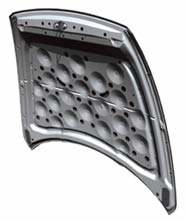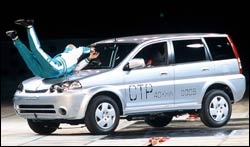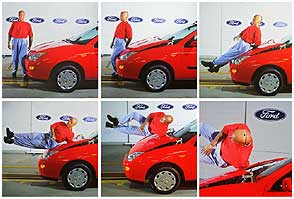NEW YORK (CNN/Money) -
As you step off the sidewalk, chatting on your cell phone, you look to your left and notice a new Mazda RX-8 speeding towards you.
The new Mazda has a 1.3 liter rotary engine that produces 238 horsepower and has no cylinders. But the thing that really concerns you is the car's hood. Because your head is about to slam into it.
Carmakers are thinking a lot about this sort of scenario because of new European safety rules. On Monday, regulators there signed into law a series of measures designed to help protect those who are hit by cars. Under these new rules, which codify an existing voluntary agreement with carmakers, cars sold in Europe will be tested and rated in special pedestrian crash tests.
But carmakers already have been working to improve the performance of their cars when they hit human beings. Some pedestrian-safety features are already available, even in the United States.
Each year in Europe, about 8,000 pedestrians are killed by cars and about 300,000 are injured. In the United States, there are about 4,900 pedestrian fatalities, according to the Insurance Institute for Highway Safety.
Why it's bad to get hit by a car
When you get hit by a car, the first thing that happens is that your legs get knocked out from under you. Your upper body is thrown down -- very hard -- onto the hood of the car.
That's typically the cause of serious injury, since just a couple of inches underneath the hood, in most cars, is the engine.
Automakers are trying to soften the blow.
 |
|
| Specially designed hood of the Mazda Rx-8 |
Some methods are relatively low-tech. Take the hood of the RX-8. Instead of being made of a flat sheet of steel with a few widely spaced supports, the RX-8's aluminum hood has a deeply dimpled structure underneath, designed specifically to provide extra cushion.
"Pedestrian safety is a very, very big deal for us," said Jeremy Barnes, a spokesman for Mazda North American Operations.
Honda (HMC: Research, Estimates) has also implemented passive protection measures like break-away windshield-wiper hinges. (Wipers are another damaging point of contact as the pedestrian slides headlong toward the windshield.)
 |
|
| Honda's special pedestrian dummy tests the new safety features. |
The front ends of several Honda models now sold in the United States were designed with the input of Honda's own POLAR II pedestrian dummy. Honda claims to be the first auto company to create such a dummy. Packed with impact sensors, pedestrian dummies like POLAR II provide researchers with a way to test their designs and technology. They are designed to respond to an impact the way a live human being would.
Based largely on the input of tests with pedestrian dummies, the Honda Civic, CR-V, Pilot, Element and Accord and the Acura TSX and RSX include hoods and fenders designed to bend to absorb an impact with a human body.
More advanced technology is now in the works that will help meet more demanding pedestrian safety tests set to be in place in Europe by 2010.
One system involves a front bumper detector that can tell, almost instantly, whether a car is hitting a hard object, like a wall or light post, or a human leg. Auto technology suppliers Siemens VDO (SI: Research, Estimates) and Autoliv (ALV: Research, Estimates) are perfecting systems like this.
 |
|
| Ford demonstration of pedestrian-protection technology. |
If a strip of fiber-optic detectors spanning the front bumper indicates that the car has struck a person, the hood of the car immediately moves slightly up and straight back, providing a few crucial inches of extra cushioning above the engine. Airbags housed at the base of the windshield will also instantly inflate, providing a protective cushion over the wiper blades and windshield.
You shouldn't expect to see more advanced systems like this on cars in the U.S., though, said Patrick Jarboe, a spokesperson for Autoliv. Certainly, unless regulators here required such pedestrian protection, consumer demand would not drive adoption of the systems, which would add about $200 to the price of a car, he said.
"It's hard to imagine that a customer would say 'Wow, I really I need that on my car because I hit a lot of pedestrians'"
Researchers at Ford (F: Research, Estimates) in Germany, working with an entire "family" of crash test dummies that includes a model six-year-old, have created a demonstration version of a Ford Focus incorporating a similar system. Ford's demonstration car also has a bumper that's been specially designed to minimize injury to a pedestrian's legs. The car's headlamp housing were similarly designed to reduce injury.

|

